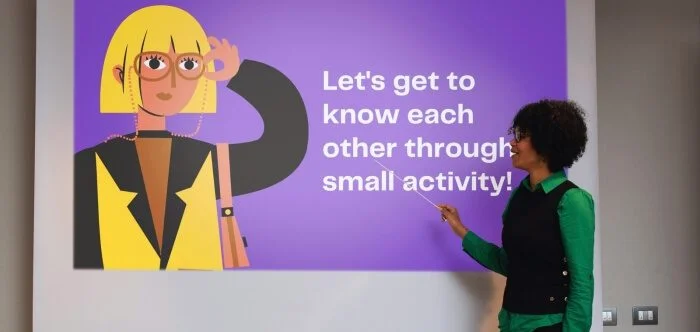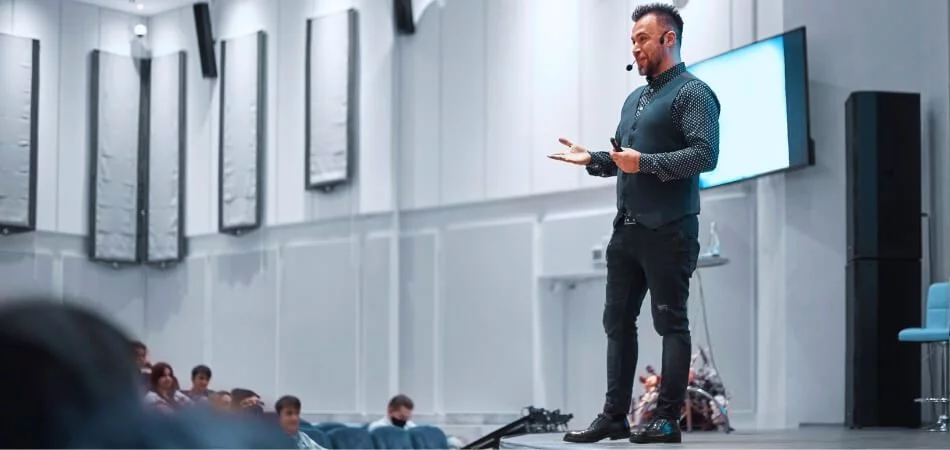Are you wondering whether your conference presentation hit the mark or fell flat? It’s crucial to gauge your audience’s reaction to assess its effectiveness. So, “How do you know if your conference presentation is bad?”
Simply look out for clues like a disengaged audience, negative feedback, a lack of questions, and difficulties in conveying your message or adhering to time limits. These indicators can be subtle but they speak volumes about your presentation’s effectiveness.
Whether you’re new or experienced, understanding bad presentation indicators is key. So, let’s dive in and discover how you can captivate your audience and leave a lasting impression. make it simple
Conference Presentation- What is it About?
A conference presentation is a dynamic event where a speaker shares information, insights, or research with a live audience. These presentations aim to inform, engage, and often persuade attendees on a specific topic. Presenters employ various multimedia tools, such as slides and visuals, to enhance understanding and maintain audience interest.
Conference presentations cover diverse subjects, spanning from academic research findings to business strategies, industry trends, or personal experiences. They offer a platform for experts, professionals, and enthusiasts to communicate their knowledge, share valuable perspectives, and facilitate meaningful discussions among attendees.
Successful conference presentations hinge on effective communication, clarity, and audience engagement. Presenters strive to convey their message concisely and compellingly, fostering a connection with the audience and leaving a lasting impression.
What are the Components of a Conference Presentation?
Crafting a compelling conference presentation involves a blend of art and science, incorporating several key components that collectively ensure your message is well-received and memorable. Let’s explore these crucial elements, which are the building blocks of a successful presentation:
Clear Objective
Begin with a clear objective that outlines what you aim to achieve with your presentation. Define your main message and ensure it’s specific and concise. This sets the direction for your entire talk. Your objective guides both your content and the expectations of your audience.
Engaging Opening
Grab your audience’s attention right from the start. Use a compelling story, a thought-provoking question, or a surprising statistic to pique their interest and establish a connection. An engaging opening sets the tone for the rest of your presentation.
Structured Content
Organize your content logically. Use clear subheadings and a logical flow to guide your audience through your presentation. Each section should build upon the previous one to maintain coherence. Consider using signposts or transitions to help your audience navigate your talk smoothly.
Visual Aids
Utilize visual aids like slides or charts to complement your verbal communication. Keep visuals uncluttered, use legible fonts, and incorporate relevant images or diagrams to enhance understanding. Visuals should support your message, not overwhelm it.
Engagement Techniques
Actively engage your audience throughout your presentation. Encourage questions, incorporate interactive elements like polls or group discussions, and maintain eye contact to foster a connection. Engaging your audience helps keep their attention and promotes participation.
Memorable Conclusion
Summarize your main points and restate your key message in the conclusion. Leave your audience with a lasting impression or a call to action that encourages further exploration or discussion. A memorable conclusion ensures that your audience leaves with a clear takeaway from your presentation.
By incorporating these components into your conference presentation, you’ll not only deliver a more impactful talk but also increase your chances of leaving a lasting impression on your audience. Each element contributes to the overall effectiveness of your presentation, making it more engaging and memorable for your listeners.
How Do You Know If Your Conference Presentation Is Bad?
Delivering an effective conference presentation is crucial for sharing your research or ideas successfully. However, determining whether your presentation falls short can be challenging. Here is an Exploration of how do you know if your conference presentation is bad:
Lack of Engagement
When your audience seems disinterested, distracted, or disengaged, it’s a clear indication that your presentation is not resonating. Watch for signs of fidgeting, yawning, or attendees checking their phones. To address this, consider incorporating anecdotes, visuals, or interactive elements to keep your audience engaged.
Confused Expressions
If you notice puzzled looks, furrowed brows, or people exchanging perplexed glances, your message may be unclear or too complex. Clarity is key to a successful presentation. Simplify your language, use relatable examples, and provide a clear structure to help your audience follow along.
Minimal Interaction
Few or no questions, comments, or reactions from the audience can be a red flag. A lack of interaction suggests that your content or delivery isn’t stimulating discussion or curiosity. Encourage participation by asking open-ended questions, encouraging discussion, or using audience response tools.
Audience Checking Time
When attendees frequently check their watches or the clock, it signals that they may be eager for your presentation to conclude. This implies a loss of interest. To avoid this, manage your time effectively and ensure your presentation remains engaging throughout.
Inattentive Behavior
Yawning, daydreaming, or whispering among the audience members can indicate boredom. A distracted audience is unlikely to absorb your message. Maintain eye contact, vary your tone and pace, and use visuals to break the monotony and capture attention.
Unclear Takeaways
If audience members struggle to articulate the main points or key takeaways from your presentation when asked, your message may not have been effectively communicated. Summarize key points throughout your talk and conclude with a clear recap of your main message.
Sparse Applause or Feedback
Lackluster applause or feedback at the end of your presentation is another indicator of its quality. A well-received presentation typically garners positive responses. Encourage feedback, and be open to constructive criticism to improve your future presentations.
Recognizing these signs and taking proactive steps to address them can help you gauge the effectiveness of your conference presentation. By continuously refining your approach based on audience feedback and engagement, you can ensure your next presentation leaves a lasting impact.
Common Mistakes to Avoid While Delivering Presentation
Delivering a successful presentation is crucial for effective communication. Avoid these common pitfalls to ensure your presentation’s success.
- Overloading Slides: Crowded slides with too much text or information can overwhelm the audience and hinder comprehension.
- Ignoring Audience Needs: Failing to consider your audience’s interests and needs can result in a disconnected presentation.
- Lack of Preparation: Inadequate rehearsal can lead to stumbling, forgetting key points, and eroding your confidence during the presentation.
- Reading Slides Aloud: Reading directly from your slides can bore the audience and diminish your credibility as a speaker.
- Neglecting Visuals: Poorly designed visuals or lack of engaging graphics can make your presentation visually unappealing and less memorable.
- Ignoring Time Limits: Exceeding allotted time disrupts schedules and can leave the audience disengaged or impatient.
Avoiding these common presentation mistakes will help you deliver a more engaging and effective presentation that leaves a lasting impression.
Essential Tips to Improve Your Conference Presentation
Delivering an impactful conference presentation goes beyond sharing information; it’s about effective communication. Here are some essential tips to enhance your presentation skills and make a lasting impression on your audience.
Clear and Concise Content
To begin, carefully structure your presentation to convey a clear and concise message. Simplify complex concepts, eliminate jargon, and focus on the most important points. Use real-world examples and stories to make your content relatable.
Engaging Opening
Capture your audience’s attention from the very beginning with an engaging opening. Share a compelling story, pose a thought-provoking question, or present a surprising fact. Your opening should set the stage for the rest of your presentation.
Visual Impact
Leverage visuals like slides, charts, and images to enhance the understanding and retention of your content. Ensure your visuals are simple, relevant, and visually appealing. Use them as aids to reinforce your message, not as a script.
Audience Interaction
Encourage active participation from your audience throughout your presentation. Pose questions, conduct polls, or initiate discussions. Interacting with your audience fosters engagement and a stronger connection. It also helps you gauge their understanding and adjust your presentation accordingly.
Practice and Timing
Practice your presentation multiple times to refine your delivery and become more comfortable with the material. Pay attention to your pacing to ensure you stay within the allotted time. Practicing boosts your confidence and minimizes the chance of stumbling during the actual presentation.
Effective Closure
Conclude your presentation with a strong and memorable closing statement. Summarize the key takeaways and emphasize the core message of your presentation. Invite questions and provide contact information for further discussions or follow-ups, demonstrating your commitment to ongoing engagement.
By following these tips, you can create and deliver a conference presentation that gets your message across effectively and engages your audience. Remember, practice is key to mastering these skills and delivering an outstanding presentation.
Bottom Line
Understanding the signs of a boring presentation, as explored in “How do you know if your conference presentation is bad?”, is vital for improving your delivery. Engage your audience through clear content, compelling openings, and interactive elements. Incorporating visuals, practice, and a strong conclusion can leave a lasting impression.
To enhance your conference presentation, focus on audience engagement, clarity, and memorable takeaways. By embracing these essential tips, you can transform your presentation into a powerful tool for effective communication and resonance with your audience.
Remember, mastering these presentation skills takes practice and dedication. Continuously refine your approach, avoid common mistakes, and keep your audience’s needs at the forefront to ensure your next conference presentation is a resounding success.








